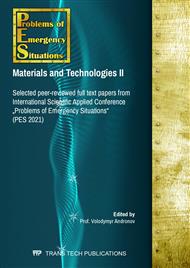[1]
M. Gaff, F. Kačík, M. Gašparík, L. Todaro, D. Jones, R. Corleto, L. Osvaldová, H. Čekovská. The effect of synthetic and natural fire-retardants on burning and chemical characteristics of thermally modified teak (Tectona grandis L. f.) wood. Constr. and build. mat. 200 (2019) 551-558.
DOI: 10.1016/j.conbuildmat.2018.12.106
Google Scholar
[2]
T. Mariappan, Recent developments of intumescent fire protection coatings for structural steel: A review. J. of Fire Sci. 34.2 (2016) 120-163.
DOI: 10.1177/0734904115626720
Google Scholar
[3]
A.I. Kovalov, Y. A. Otrosh, S. Vedula, O.M. Danilin, T. M. Kovalevska, Parameters of fire-retardant coatings of steel constructions under the influence of climatic factors. Nauk. Visn. NHU. 3 (2019) 46–53.
DOI: 10.29202/nvngu/2019-3/9
Google Scholar
[4]
M.R.D. Silveira, R.S. Peres, V.F. Moritz, C.A. Ferreira, Intumescent coatings based on tannins for fire protection. Mat. Res. 22.2 (2019).
DOI: 10.1590/1980-5373-mr-2018-0433
Google Scholar
[5]
L. Andryushchenko, V. Borysenko, О. Kudin, M. Goroneskul, Intumescent fire protective coatings in modern building (review). Prob. of Emerg. Sit. 1.29 (2019) 121-138.
Google Scholar
[6]
L.M. Vakhitova, K.V. Calafat, V.L. Drizhd, N.А. Taran L.M. Litvinenko, Chemical solutions of fire protection problems. Sci. and Innov. 6.11 (2015) 47-56.
DOI: 10.15407/scine11.06.039
Google Scholar
[7]
O.A. Zybina, Theoretical principles and technology of intumescent fire-retardant materials. St. Petersburg, (2015).
Google Scholar
[8]
A.S. Krutolapov, E.G. Korobejnikova, Analysis of domestic patents for inventions (1994-2016) in the field of creation of fire-protective coatings. Vestn. St.-Peterb. Univ. GPS MCHS Ros. 3, (2018) 31-38.
Google Scholar
[9]
V.I. Nateeva, L.I. Keldysheva, Study of intumescent fire retardant coatings based on water- and organic-soluble film-formers with a cheap filler. Vestn. Kaz. Techn. Univ. 20.15 (2017) 50-53.
Google Scholar
[10]
V.M. Balakin, A.M. Seleznev, K.V. Belonogov, Primary assessment of fire retardant properties of intumescent coatings based on various aqueous dispersions. Pozharovzryvobez./Fire and Expl. Saf. 19.6 (2010) 14-18.
Google Scholar
[11]
L.N. Vakhitova, N.A. Taran, V.L. Drizhd, S.P. Prydatko, Fire-retardant efficiency of intumescent coating in the presence of nano-sized compounds under hydrothermal ageing. Od. Nat. Univ. Her. Chem. 20.2 (2015) 83-92.
DOI: 10.18524/2304-0947.2015.2(54).50634
Google Scholar
[12]
O. Hryhorenko, Ye. Zolkina, N. Saienko, Y. Popov, R. Bikov, Investigation of adhesive-strength characteristics of fire-retardant epoxy polymers modified with metal-containing additives. IOP Conf. Ser.: Mat. Sci. and Eng. 907.1 (2020) 1-6.
DOI: 10.1088/1757-899x/907/1/012060
Google Scholar
[13]
V.A. Ushkov, Inflammableness and smoke-generating ability of polymer composite materials. Vestn. MGSU. 12.8.107 (2017) 897-903.
DOI: 10.22227/1997-0935.2017.8.897-903
Google Scholar
[14]
O. Hryhorenko, N. Saienko, V. Lypovyi, S. Harbuz, Research of effectiveness of wood fire protection by modified epoxy polymers. Int. Sci. Conf. on WFS 2020. Springer, Cham. (2020) 125-128.
DOI: 10.1007/978-3-030-41235-7_19
Google Scholar
[15]
I.G. Malodyka, Experimental studies of fire-retardant coatings for wood based on epoxyamine compositions modified with inorganic salts. Sci. Bul. of Civ. Eng. 37 (2006) 180-188.
Google Scholar
[16]
R.A. Yakovleva, Y.V. Popov, N.V. Saienko, E.Yu. Shevtsova, Fire&bio resistant epoxy compositions for wood protection. Adv. in Chem. and Chem. Techn. 6.74 (2007) 23-28.
Google Scholar
[17]
R. Jakovleva, E. Spirina-Smilka, Yu. Popov, N. Sajenko, S. Novak, V. Kovalenko, O. Gudovich, L. Shafran. Influence of fire-retardants on fire danger indicators of epoxypolymer materials. J Fire Saf. 29 (2011) 175-181.
Google Scholar
[18]
V.-P. Parhomenko, H. Lavrenyuk, B. Mykhalichko, Utilization prospects of the silicon-containing fire retardants for the combustibility suppressing of the epoxy composites. Bull. of Lviv State Univ. of Life Saf. 15 (2018) 94-100.
Google Scholar
[19]
Yu. M. Danchenko, Yu.V. Popov, E.S. Barabash, Influence of acid-base properties of the surface of polymineral fillers on the structure and characteristics of epoxy composites. Iss. of Chem. and Chem. Techn. 3 (2016) 53-60.
Google Scholar
[20]
C.J. Anderson, J. Dziuk, W. Mallow, J. Buckmaster, Intumescent Reaction Mechanisms. Journ. of Fire Sci. 3 (1985) 161-194.
DOI: 10.1177/073490418500300303
Google Scholar
[21]
E.D. Weil, Fire-protective and flame-retardant coatings-A state-of-the-art review. Journ. of Fire Sci. 29.3. (2011) 259-296.
DOI: 10.1177/0734904110395469
Google Scholar
[22]
V V.-P. Parhomenko, V. Kochubei, B. Mykhalichko, H. Lavrenyuk, Yu. Pavlovskyi, Influence of the copper (II) hexafluorosilicate onto thermaloxidative stability of the self-extinguishing epoxy-amine composites. Fire Saf. 30 (2017) 132-136.
DOI: 10.1016/j.firesaf.2016.01.001
Google Scholar
[23]
DSTU-N-P B B.1.1-29: 2010 Fire protection. Fire-retardant treatment of building structures. General requirements and control methods. Kyiv, (2011).
Google Scholar


